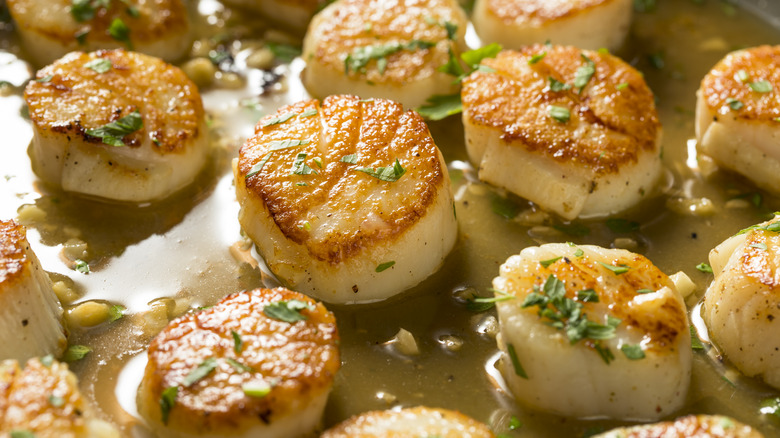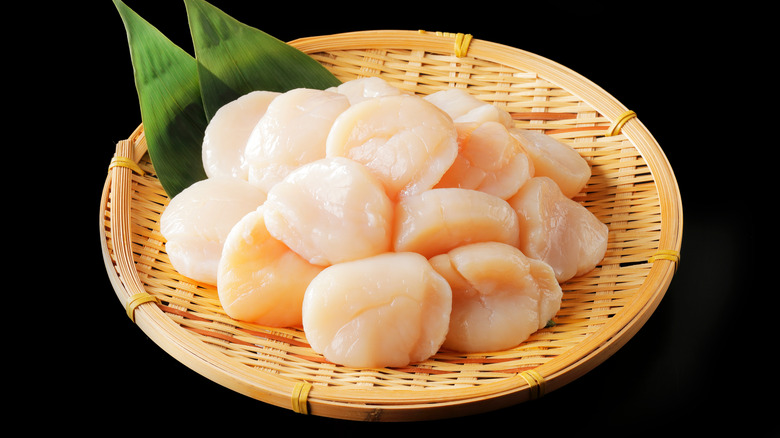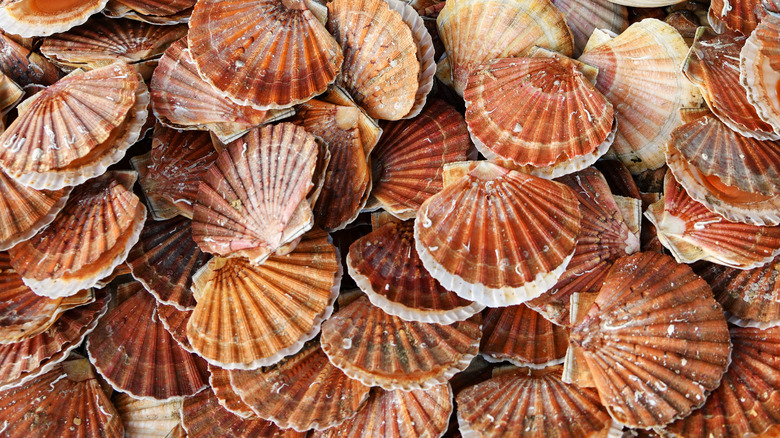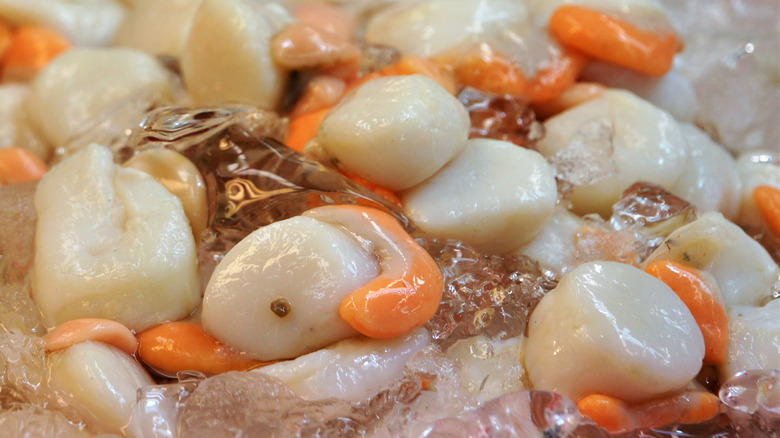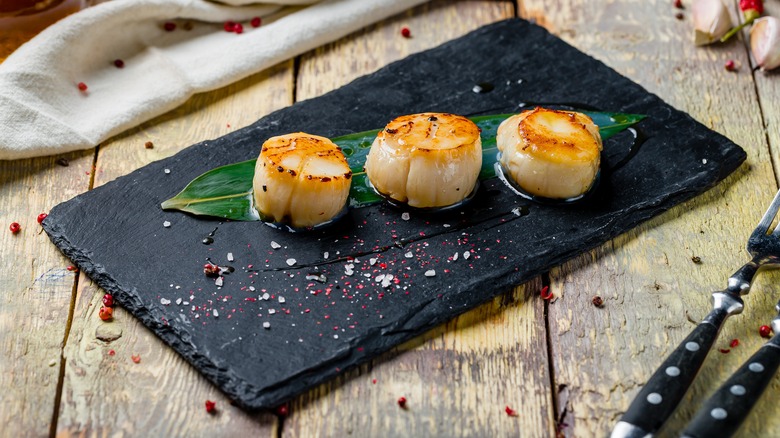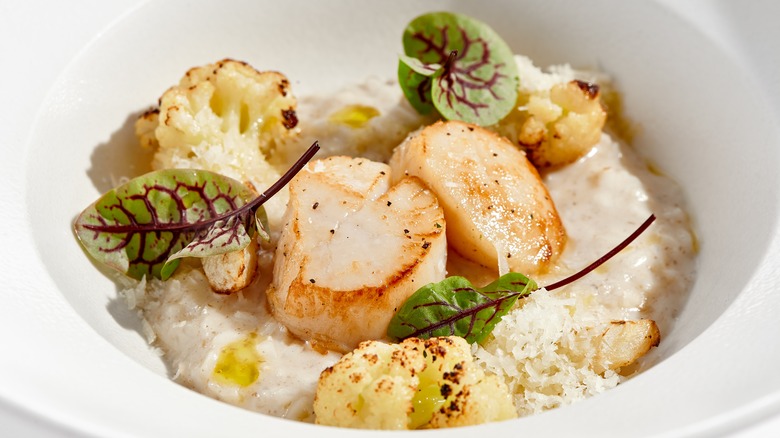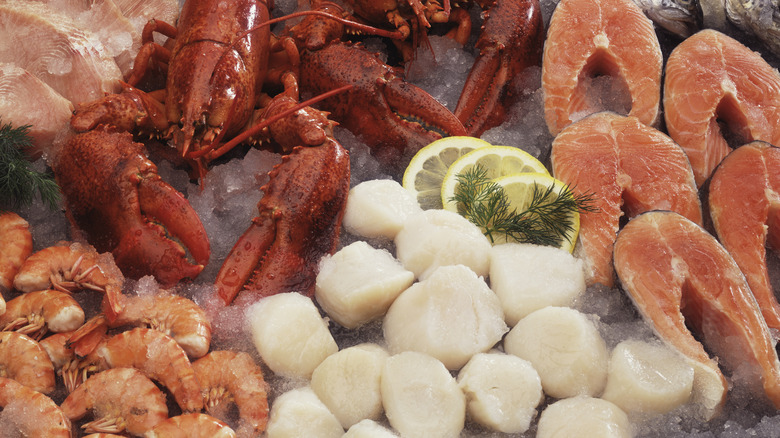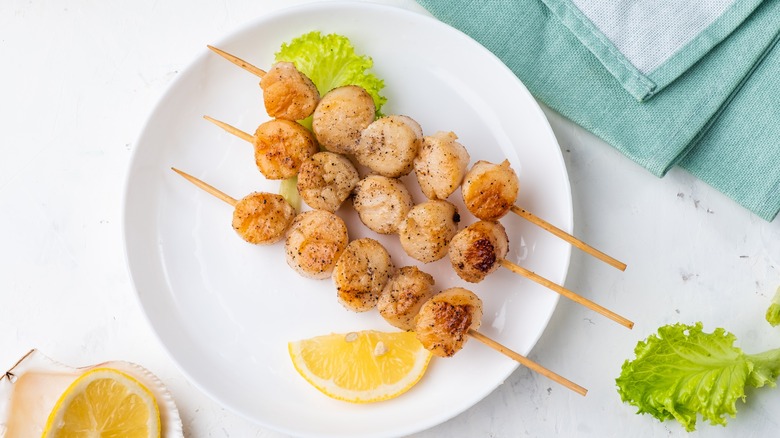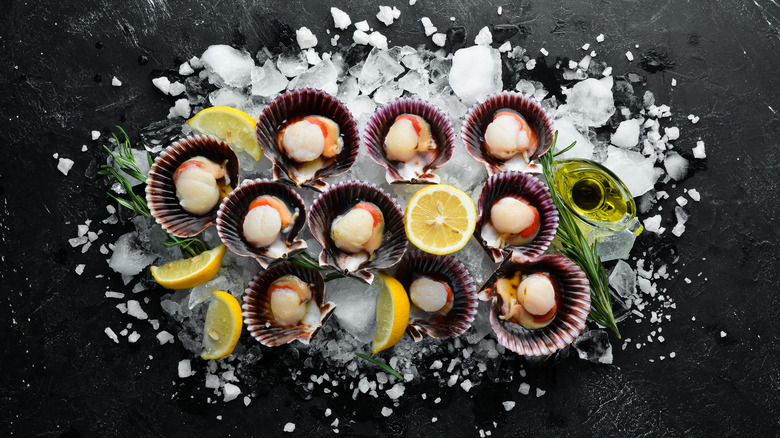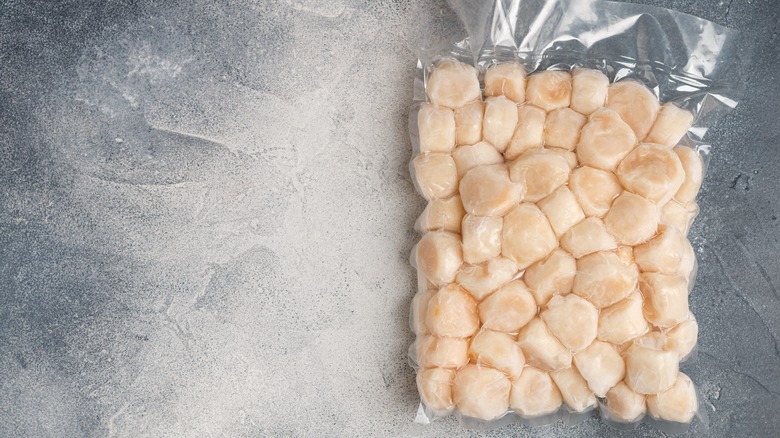What Are Scallops And What Do They Taste Like?
Seafood represents the most widely traded food commodity globally. Over 3 billion individuals consume wild-caught and farmed seafood as their primary source of animal protein. Approximately 14 percent of worldwide seafood consumption is bivalve mollusks (via Goods and Services of Marine Bivalves). A vast majority of bivalve mollusks come from aquaculture, with only 11 percent being wild-caught. Bivalve mollusks are twice as in-demand as crustaceans, making them an integral part of our worldwide food supply.
The most commonly consumed bivalve mollusks are clams, mussels, oysters, and scallops. These are all members of the taxonomic class Bivalvia and the phylum Mollusca — although they belong to distinct subclasses, orders, and families. All bivalves have two shells that encase their gelatinous and fragile bodies. They predominantly feed off of plants, algae, and bacteria, which get filtered through hair-like cilia. Due to this digestion process, their diet imbues bivalves with the distinctive flavors of the lakes, rivers, or oceans that they call home.
From a culinary perspective, the scallop is one of the most distinctive and delectable bivalve mollusks. Chefs and food lovers delight in their unique, meaty texture and relative ease of preparation when compared to their bivalve cousins. To understand why they are so notable, let's delve further into what scallops are and what they taste like.
What are scallops?
Like clams, mussels, and oysters, Scallops are bivalve mollusks. They have two shells joined with a hinge within, which is nestled by a strong muscle called the adductor. This muscle gives the scallop its most unique characteristic among bivalves — scallops can swim. As the adductor expands and contracts, it opens and closes the creature's shells, expelling water from one end and causing the scallop to swim in the opposite direction.
One can find scallops nestled in the sand at the bottom of the water source they inhabit. Their shells have one flat side and one more rounded side, which is the side that gets buried under the sand. These shells are distinctly delicate, necessitating that scallops get shucked at the moment they get harvested. All other mollusks are typically harvested alive and sold with shells intact to preserve their freshness. The portion of the scallop that we consume is its adductor muscle.
These mobile creatures navigate their environment with 100 keen eyeballs, which can get found along the rim of their shell. The eyeballs can decipher dark, light, and motion, utilizing human-like retinas. The primary diet of scallops consists of algae, krill, plankton, and larvae.
What do scallops look like?
Since there are nearly 400 different species of scallops inhabiting saltwater environments — ranging from bays to estuaries to the ocean floor — their size, color, and shape widely varies. Like all bivalve mollusks, scallops have two shells joined by a hinge. These shells are generally ellipsoid and have ribbed edges. The top is typically burnished in color, while the bottom is more of an eggshell shade. Approximately five to ten percent of sea scallops are albino, meaning their shells are a stark white. Sea scallops have less distinctly scalloped shells, likely resulting from their need to be more hydrodynamic. The size of scallops ranges from a few millimeters to up to three feet in diameter — although the average sea scallop is approximately six inches in diameter.
The interior of the scallop gets dominated by the large, round adductor muscle responsible for its mobility. This muscle is generally opaque, with a whitish hue — although some may be pinkish. The other most visible part of the interior of the scallop is the coral, which is the reproductive organ of the scallop. Since scallops are hermaphrodites, the coral has two sections: a small grayish male portion, and a prominent orange-hued female section. Generally, the coral should be removed when harvesting scallops. Once out of the shell, you'll notice a skin-like flap called the catch — where the scallop was attached to its shell-casing. This should also be removed before cooking.
Wet, dry, diver, and dayboat scallops explained
How scallops get harvested directly impacts their flavor, texture, and cooking process. It's crucial to know whether your scallops are harvested wet or dry. When wet scallops get harvested, they're placed in a bath of cold sea water augmented with an artificial preservative known as sodium triphosphate. This process causes the scallops to plump up and look artificially larger than their weight at harvest. However, it also renders them nearly impossible to sear even after thawing and drying the scallops. Additionally, you end up paying for water weight rather than actual meat. You should only purchase wet scallops for recipes where the scallop texture isn't critical like for a chowder.
Dry scallops are harvested, shucked, cleaned, and flash-frozen within four hours without using artificial preservatives. Their shelf-life may be shorter, but they retain their original shape and texture. Many consumers swear they can taste the difference between wet and dry scallops, claiming wet ones have a soapy aftertaste. If you plan to pan-sear scallops, opt for dry scallops.
Diver scallops refer to scallops deep sea divers wild-caught by hand — rather than using a net to dredge the ocean floor. These scallops are a far more environmentally sustainable option for consuming scallops, although they're pricier. Dayboat scallops are dry scallops harvested on smaller fishing boats from December through February. They are generally sold within 24 hours of harvest and are especially valuable.
What do scallops taste like?
Unlike clams, oysters, and mussels, scallops do not have an aggressively salty and fishy flavor. The most commonly used words to explain what scallops taste like are nutty and sweet. Scallops are rife with free amino acids and high proportions of glycogen, which gets converted to glucose when heated. As such, scallops evolved to naturally caramelize when cooked, which amplifies their natural sugars and mimics flavors similar to almonds.
Their flavor often gets equated to shrimp or lobster. While there is some similarity, scallops tend to have a slightly less oceany flavor and firmer texture than most seafood. Their taste and texture are also dependent upon the origin of the scallop. Sea scallops tend to be meatier, while bay scallops tend to melt in your mouth. For those who aren't typically fish or shellfish lovers due to briny flavors, scallops make great gateway seafood dishes.
How to cook scallops
The most vital fact to remember when cooking scallops is they are easily overcooked. Scallops quickly turn from a delicacy to something more akin to a rubber ball. However — some basics can ensure your scallops are perfect every single time. First, if you use frozen scallops, thaw them thoroughly. Then remove the catch or flap of skin where the scallop was attached to its shell. Next, pat the scallops dry with a paper towel, or they will steam rather than sear, impeding their natural tendency to caramelize. Third, make sure to season them before cooking. We enjoy using a hint of sumac, a spice with a slightly lemony flavor that accentuates the buttery and nutty scallop. Finally, the fat should be conducive to high-heat cooking. Butter is one such type of fats; unlike olive oil, which burns at high heat.
Once you have prepared the scallop properly, you can pan-sear, bake, grill, broil, poach, or use them in a ceviche. However you prepare them, make sure you use the proper type of scallop for the recipe. Bay scallops are better suited for ceviche and chowders. Sea scallops are ideal for grilling, pan-searing, baking, and broiling. Always cook your scallops last minute, right before serving your meal. We enjoy scallops topped with an acidic sauce — like a Beurre Blanc or a bright, herbaceous pesto.
Where to buy scallops
According to the Monterey Bay Aquarium Seafood Watch, scallops are a relatively sustainable seafood option. Bay scallops are found in shallow waters off the East Coast of the U.S. or imported from Mexico and China, with China responsible for approximately 85% of the world's farmed scallops. Sea scallops inhabit oceans across the globe in cold waters approximately 200 meters deep. While scallops are available year-round, their peak season is the fall and winter. Scallops are sold on a per-pound basis: For example, U10 indicates ten scallops per pound and U20 equals 20.
Fresh scallops should be purchased from reputable seafood suppliers — either near where they're harvested or in a larger metropolitan area with access to shipments of fresh seafood. They should never have a fishy or sulfuric odor. If you find them sitting in an off-white viscous liquid, they're heavily treated with sodium tripolyphosphate (STPP), which indicates they were wet harvested.
Frozen scallops may be a better option for most populations in the U.S. Since scallop shells are notoriously delicate, most scallops are shelled and frozen immediately upon harvesting. Flash freezing preserves freshness and is the safest way to guarantee that your scallops are not past their prime. Be sure to keep an eye on freezer burn before purchasing frozen scallops.
Nutritional information about scallops
Scallops, like other seafood, can be part of a healthy diet — depending on how they get prepared. They are a high-protein and low-carbohydrate food source that is relatively low in calories — just 137 calories per 100-gram serving (via Verywell Fit). While scallops are minimal in fat, they are high in cholesterol and sodium. One serving of scallops contains 660 milligrams of sodium, almost 29% of the USDA recommended daily allowance for sodium intake. Additionally, scallops may be contraindicated for those with seafood or shellfish allergies — even if they aren't allergic to scallops per se, as there is often cross-contamination potential with other shellfish during food preparation.
As far as vitamins and minerals are concerned, scallops are nutritional powerhouses. They possess abundant selenium, zinc, phosphorus, B12, taurine, calcium, potassium, iron, and magnesium. Additionally, scallops are replete with heart-healthy omega-3 fatty acids. Scallops are also one of the few seafood options listed as one of the "best" choices for pregnant women to consume by the American College of Obstetricians and Gynecologists. This list indicates those seafood options with low enough mercury content to be safe for pregnant women. (However, it's recommended that scallops get eaten no more than two to three times per week while pregnant and must be fully cooked for maximum safety.)
Varieties of scallops
There are two basic types of scallops: bay and sea scallops. Bay scallops typically get sourced from saltwater estuaries and shallow waters surrounding the Atlantic coast of the U.S. They are small in dimension, ranging from 80-120 scallops per pound. These scallops are generally sweeter and have a more delicate texture than sea scallops. They are best suited for simple recipes like casseroles, chowders, stews, and ceviche.
Sea scallops typically get sourced from the deep, cold, salty Atlantic ocean waters. They are three or more times larger than bay scallops, ranging from 10-30 scallops per pound. Sea scallops have a meatier texture and saltier flavor. They are best pan-seared, grilled, baked, or broiled. Their size makes them ideal for a main entree.
Calico scallops are cousins of the bay scallop. They are tiny scallops with brightly colored and speckled shells. Their meat is darker than a traditional bay scallop, with a tender texture and nutty flavor. They usually get found in warmer waters than regular bay scallops in the Gulf of Mexico. The best way to enjoy Calico scallops is to steam them or serve them raw in a ceviche.
How to store scallops
Scallops, like other seafood, are quick to spoil. The best way to keep scallops fresh is in a tightly sealed, airtight Ziploc bag placed over ice cubes in the refrigerator. Using ice will guarantee your scallops stay at a temperature between 32 and 41 degrees Fahrenheit. Properly stored, scallops will last for three days. However, they're best when eaten on the day of purchase.
Cooked scallops will also last for three to four days when refrigerated. After the scallops get cooked, they should be cooled within two hours before being transferred to a Ziploc bag. You can place the sealed bag of cooked scallops in the refrigerator or the freezer for storage for up to three months.
To avoid freezer burn, transfer frozen scallops to a Ziploc bag. Re-packaged scallops should always get stored in the coldest part of the freezer rather than on the freezer door. Frozen scallops can last for up to three months. Always thaw frozen scallops properly in the refrigerator. To thaw, remove the scallops from their packaging and place them in a large glass bowl sealed with plastic wrap. They should thaw overnight. Never refreeze thawed scallops.
